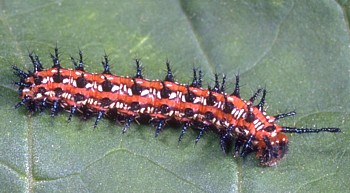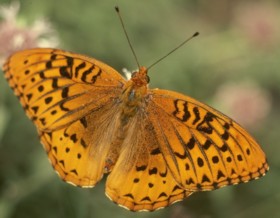|
|
ARTHROPODS:
Insects»
Spiders»
Centipedes»
Millipedes»
Sowbugs»
Harvestmen»
Mites
& Ticks»
Scorpions»
Identification
Tips»
About
the Critter Files»
Links» |
|
|
|
| Fritillaries
are a smaller group within the butterfly family Nymphalidae. All
butterflies in this family have tiny front legs that lack claws
(in most other butterfly families, the front legs have claws). This
family includes many other common butterflies, including viceroys,
checkerspots, and heliconians. Togther, all of the butterflies
in this family are known as "brush-footed butterflies."
The fritillary subfamily
is called Argynninae. Fritillaries are usually medium- to
large-sized, and their wings are brownish-orange with wavy black
lines and spots. As with all butterflies, fritillaries have
scaly wings and coiled mouthparts.
Since most fritillaries
look very similar, wing patterns must be closely examined and compared
with pictures in field guides for accurate identification. There
are also a few species of Checkerspots and Crescent butterflies
(also in the Nymphalidae family) that look very much like fritillaries.
Detailed pictures of
fritillaries and similar buterflies are available in the following
field guides:
Butterflies and Moths
by Mitchell and Zim
Peterson Field Guide to Eastern Butterflies by
Opel and Peterson
|
| |
| Fritillary
caterpillars
vary in color depending on the species, but most feature 6 rows of
branching spines that go all the way down their bodies. |
| |
 Fritillary Caterpillar (R. Bessin, 2002)
Fritillary Caterpillar (R. Bessin, 2002) |
|
| SIZE:
Adult wingspan up to 3 3/4", caterpillar up to 2" |
| |
| LIFE
CYCLE |
|
As
with all butterflies, fritillaries have complete metamorphosis with
egg, larval, pupal, and adult stages. Adults are active all
summer long. Most species overwinter as larvae. |
| ECOLOGY |
|
Fritillary adults and
caterpillars are very common in fields, meadows, and other weedy
areas. The caterpillars feed on violet. The adult butterflies
feed only on nectar.
Although the spines on
the backs of fritillary caterpillars provide them with some defense,
they are nevertheless eaten by a wide variety of predators, including
birds, spiders, and other insects. The adult butterflies are
preyed upon by birds and flying insect predators, like robber flies
and dragonflies.
|
| |
| PEST
STATUS |
|
Fritillaries
are not considered pests. |
| |
| COMMON
KENTUCKY FRITILLARIES |
|
|
MEADOW
FRITILLARY
GENUS and SPECIES:
Boloria bellona |
| |
 Meadow Fritillary
( R. Bessin, 2002)
Meadow Fritillary
( R. Bessin, 2002) |
|
|
|
GREATER FRITILLARY
GENUS:
Speyeria |
| |
 Greater Fritillary (Corel Photo CD, 1993)
Greater Fritillary (Corel Photo CD, 1993) |
|
| |
| COLLECTING
& PHOTOGRAPHY |
|
Look for adult fritillaries
throughout the summer in open fields, meadows, and near the forest
edge. Some of the small species are fast fliers, and can be
difficult to catch. Use a butterfly net when capturing these
butterflies to keep from damaging the wings.
Once captured, it is
best to keep any butterfly in a "butterfly envelope".
Visit this page to learn how to make your own butterfly envelopes:
http://www.kellscraft.com/butterfly01.html#COLLECTIONS
Butterflies make great
photography subjects, but getting a good picture can be a challenge
- even when the butterflies aren't flying, they are almost always
walking around or moving their wings up and down. One technique:
find a fritillary early on a cool summer morning. It will
still be warming itself and will be less likely to fly away.
Fritillary caterpillars
are much slower moving than the adults, and can be found on wild
violets. All insect larvae should be preserved in alcohol.
If you try raising a fritillary caterpillar, remember that
it is very picky, and will only eat violet foliage. |
| |
| MYTHS
- LEGENDS - FOLKLORE |
|
Do you know any myths,
legends, or folklore about fritillaries? Let us know if you
do! |
Original document: 25 May 2004
Last updated: 25 May 2004
Monarch and Viceroy
Butterfly photos courtesy Corel, 1993. Used with permission. Other
pPhotos courtesy R. Bessin and B. Newton, University of Kentucky
The Kentucky Critter Files are maintained by Blake Newton, Department
of Entomology, University of Kentucky.
Contact: blaken@uky.edu
|
|

